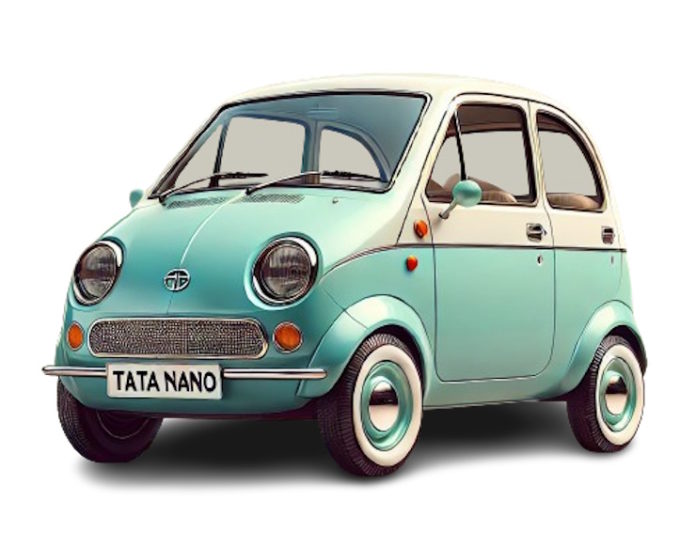The story of the Tata Nano begins in the early 21st century, a time when the Indian automotive market was on the cusp of transformation. In 2008, Tata Motors introduced the world to what was then hailed as the “world’s cheapest car.” Designed to offer affordable transportation to the masses, the original Tata Nano was a compact, no-frills vehicle with a modest 624 cc engine, producing 37 horsepower. Priced at around INR 100,000, the Nano aimed to provide a safe, economical alternative to two-wheelers for Indian families.
Despite its innovative approach, the Nano faced challenges in gaining widespread acceptance. Issues related to safety perceptions, marketing missteps, and production hurdles meant that it never quite achieved the mass appeal its creators had envisioned. However, the Nano’s legacy as an affordable, people-centric car remains. In this story, we imagine what could have happened and might happen if the Nano were produced in the past, and in the future! We asked ChatGPT to create these images, and after quite a bit of trial and error, these Nanos of the past and future were created.
A Retro-Futuristic Vision: The Nano of the 1960s
Imagine if the Tata Nano had been conceived in the 1960s. Sadly, there was no way to make a people’s car in those days. Remember that this was a time when even two-wheelers were in very limited availability and if you owned one, you were already rich. A car was for the truly upper-middle class (technically the elite class) in those days. But the Nano’ design principles could result in a beautiful looking small car such as the one you can see here.
This retro Nano would have sported a rounded, compact design with chrome accents and large, round headlamps. Under the hood, a small, air-cooled engine producing 20-25 horsepower would power the car, offering a top speed of around 70-80 km/h. Considering the roads of the 1960s, that would have bee more than adequate.
Priced at an affordable INR 5,000-7,000, this 1960s Nano would have been a hit among middle-class Indian families, providing an upgrade from scooters and public transportation. Its simplistic design, reliability, and low running costs would make it a symbol of modernity and progress, much like the Volkswagen Beetle or the Fiat 500 in their respective markets. Imagine your grandparents looking at the 60s Nano in awe!
Leaping Forward: The Nano of 2030

Sure, the Nano is dead as of now, but everything can be revived! Fast forward to 2030, and the Tata Nano undergoes a significant transformation to meet the demands of a technologically advanced and eco-conscious society. The 2030 Nano is a sleek, electric vehicle powered by a state-of-the-art battery pack, offering a range of 300-400 km on a single charge. Its compact electric motor delivers 100-150 horsepower, allowing for a smooth and efficient drive.
The car features a spacious, luxurious interior with a minimalist dashboard dominated by a large touchscreen infotainment system. Advanced safety features, including adaptive cruise control, lane-keeping assist, and a 360-degree camera system, ensure a safe and comfortable ride. It goes without saying that the 2030 Nano would meet all safety standards of the day.
The 2030 Nano appeals to urban dwellers and young professionals seeking an affordable, safe and eco-friendly vehicle. We can expect full self-driving in the 2030 Nano (or whatever new name it can come under).
The Pinnacle of Innovation: The Nano of 2100 AD

The journey of the Tata Nano takes us to 2100 AD, where its current bubble shape goes even more futuristic, far surpassing that of the Tata Pixel and Megapixel concepts. This iteration of the Nano is a fully autonomous, networked vehicle, capable of both ground travel and flight. Powered by advanced fusion cells (haha, its imagination so deal with it!), the 2300 Nano offers near-infinite energy with zero emissions.
We expect that all cars of 2100 AD will be fully interconnected, which means their AIs could interact with each other to drive perfectly without any input from their drivers – and the Nano is going to be the same.
In the air, drone-like rotors enable vertical takeoff and landing, allowing for seamless transitions between different modes of travel. The car’s AI-driven systems ensure total autonomous driving, communicating with other vehicles and smart infrastructure to avoid traffic bottlenecks and eliminate the risk of collisions.
The interior is a high-tech sanctuary, featuring reconfigurable seating, AR and VR interfaces, and health monitoring systems. Passengers enjoy a climate-controlled environment with noise-cancellation technology, convertible seating and adjustable lighting. The Nano of 2100 is a technological marvel.
The post Tata Nanos Of The Past, Future and Far Future! first appeared on Cartoq.
Source link

